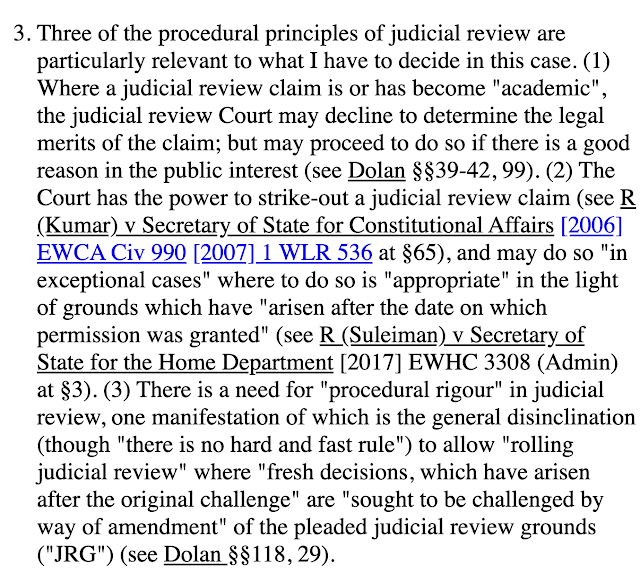The paramountcy of paragraphination over pagination is a recent, but welcome addition to English law. Pinpointing to paragraphs is perfect for our digital age, and works around the problems of having to neatly mark pagination in digital continuous formats (a severe problem for un-paragraphed American system). However, the admission of paragraphs to the English stylistic family still provokes difficulties in citations, even for members of the Judiciary. This was recently highlighted clearly by the judgment of Fordham j in the recent case of R (Hussain) v Secretary of State for Health And Social Care [2022] EWHC 82 (Admin), in which his Lordship insistently denotes paragraphs in the manner seen in the image below. This usage creates two issues: of spacing, and of choice of indicator. (Eagle-eyed readers may also note the typewriter-era solecism of underlining rather than italicising case names, but that is a matter for another day)
Spacing
This first issue is a crucial one. His Lordship is, with the greatest of respect, stifling the poor paragraph numbers. Bringhurst teaches us that we must always allow our glyphs and punctuation the space to breathe. A failure to place a space between the unit indicator and the number loses the advantage of delineating the unit before the number. It also is utterly inconsistent with how we deal with other examples of glyph based indication. Imagine, if you can, the horrors of taking spaces from other pre-number indicators. This is most obviously demonstrated with the section-mark’s perfect equal, the letter s
, denoting a section; s1
is obviously crammed and displeasing in comparison to the universally used s 1
. Given that this standard for sectioning punctuation is inescapably established in English legal writing, there is no reason whatsoever to depart from it when using the section mark. Users of the numero glyph in place of No.
do not dispense with the space before the number either; we write both No. 1
and № 1
. Similarly, in systems which regularly use section marks in legislation (such as in the United States of America), the practice is universally to add a space (eg, the spacing in the American citation 28 U.S.C. § 1332
). His Lordship is, it is respectfully submitted, in error, and, inasmuch as His Lordship chooses to use section marks (the wisdom of which is discussed infra), spacing ought to be deployed liberally and consistently.
Why §
ought not be used for paragraphs at all
Let us start with a small bit of praise: at least his Lordship has avoided the American Blue Book error of using the pilcrow (¶
) to denote paragraphs; this is entirely ahistoric and outside of books on typography or printing, there is no place for it as a mark of paragraphs. Instead, his Lordship has chosen the section mark (§
). This glyphas a long history of being used in such a manner in treatises on the law, from modern printings of Roman Digests to, say, the first editions of Story j}'s 1834 classic Commentaries on the Conflict of Laws, which use the section mark to delineate paragraphs. The European Court of Human Rights too—somewhat insistently—uses §
to denote paragraphs. However, we are here concerned with the legal style of England & Wales, which has traditionally resisted the idea that judicial decisions have sections
. This is not uncommon in the common law world, which generally came to paragraphs later than the civilians; the Supreme Court of the United States still refuses to even adopt paragraphs out of the same conservatism. The Blue Book resorts to ¶
in error, but the motive is good: to find a way consistent with tradition to mark judicial paragraphs.
The simple fact is that there is no official or regular usage of the section mark for paragraphs in any of the traditional sources of English authority, including the style generally used by the Supreme Court, OSCOLA, or the practices of the major journals. The closest we can find any such authority is Strasbourg, but that Court's practice (not shared by the CJEU) is not much of a model, given how radically different the structure of its process and deliberations are to those of English courts. I am aware of no law report which prints section marks for domestic judgments, nor do I often see in skeleton arguments. The use of §
smacks of a clever attempt to outdo existing practice, but law is about communication, precedent, and consistency. Wildcat punctuation does not serve these noble aims.
What,then, ought the proper marking to be? There are two contenders, both of which have their merits, and both of which may be used in the appropriate time. These are, of course, the approaches ofpara 7
and [7]
. The brackets in the latter are a nice touch, because of the use already made in brackets in legal citations, although they do have the issue of brackets indicating two separate factors. I usually prefer para
, which is elegant and English (and preferred by OSCOLA). It is a shame that page and per annum are already occupying space for p
and pa
, which adds unwanted length. In footnotes or academic writing, I try to use para
, but I will frequently make use of brackets for in-line citations. I also occasionally bracket paragraph numbers in the left margin, which helps clarify that they are not section numbers. These two approaches seem to happily co-exist, and regardless of preference (as I have said, mine is usually for para
), either will do. Thus, there is ample choice and autonomy within our accepted system, and no need to try to make the use of the section mark a thing
.


Comments
Post a Comment
Contributions are always welcome!